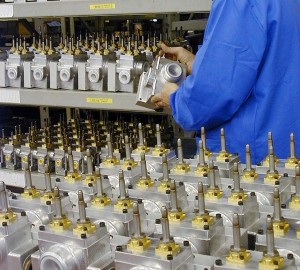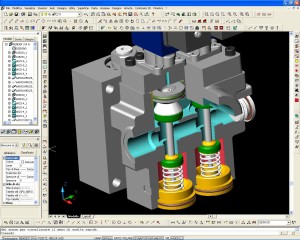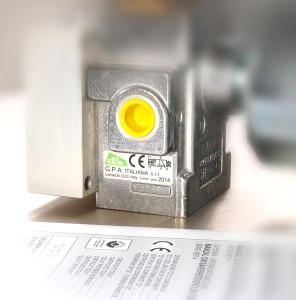For over 15 years, a renowned German Group has been availing itself of Italian technology to equip its automation solutions for mechanical presses with high-quality components, certified in compliance with the most recent regulations.

With over one century of history behind, Ortlinghaus Group represents 115 years of excellence in engineering. We are talking about a family company with headquarters at Wermelskirchen, North Rhine (Germany) today managed and run by the fourth generation, world reference partner in the production of clutches, brakes and systems for drive solutions in several sectors. Products and systems designed and manufactured thanks to the contribution given by 550 employees and production sites located in Germany, Switzerland and China, whose 60% of the turnover is addressed to the European, American, Chinese and Far East markets. «We are proud – declares i.A. Helmut Kindermann, marketing manager of the Group – of our long history and of availing ourselves of suitable structures and processes for granting the long-term stability of the Group. A vision in which targets and values converge into constant innovation and growth, too». Approach that looks at the future with a well precise strategy, that’s to say further widening competences and know-how in mechatronic systems, increasing market volumes and strengthening the global coverage. Among the products designed and implemented by the German Group, stand out also performing clutch-brake units for mechanical presses; devices that are implemented by the technology developed by G.P.A. Italiana. The company, in fact, headquartered at Lomazzo (CO), since 1962 has been designing and manufacturing equipment for presses and groups/machines for automation, with an ISO 9001 quality system certified by the German Body Tüv since 1994.
Double body and integrated dynamic self-control
Since 1997 the Como company has been supplying the German Group with the series of MEP-A solenoid valves. They are a range of executions available in 5 nominal diameters from a minimum of 10 up to a maximum of 40 mm, just suitable for the control of brake-clutch groups of mechanical presses. Since 1995 they have been certified according to the EN 692 regulation (safety of mechanical presses) by the German body DGUV (previously known as BG) that takes care of the safety of metalworking machines. Examined again by the same body in 2011, with the coming into force of the EN 13849 regulation for the assessment of the control circuit safety, they have obtained the certification of the attainment of the highest levels of safety (Category 4) and reliability (Performance level “e”). Provided with dynamic integrated self-control according to the UNI EN 692 regulation and with 2 – 8 bar working pressure, they are solenoid valves with double body, 3ways/2 Normally Closed positions, with parallel flow, sized in such a way as to limit the residual pressure in case of wrong operation beyond 3% of the feeding pressure. The mentioned dynamic integrated monitoring system does not need the presence of additional control systems for the valve check at each cycle, with consequent savings in purchase, installation and maintenance costs.

Redundancy and dynamic monitoring
In this context, why should all the manufacturers and dealers of presses attentively consider these valves? First of all, it is worth underlining that the machines sold in Europe must conform to the European Directive 2006/42/EC that defines the general criteria concerning the machine safety. Lots of technical committees are then working in the Old Continent to define specific regulations for the various machine typologies, taking the directive requisites into account. Referring to the requisites of the European EN 692 regulation for the safety of mechanical presses, the paragraph 5.4.2. concerns just “Clutch presses with partial rotation coupling: redundancy and monitoring of the control systems of the coupling/clutch group”. As far as the redundancy is concerned, this paragraph defines that the valve “that directly checks the fluid for the controlled brake-clutch group” must be “a double body solenoid valve”. Regarding instead the monitoring, the regulation establishes that the same “must be dynamic with a frequency of at least once per cycle”. How many valves today available on the market satisfy the requisites of the European EN 692 regulation? Lots of the press valves available today have double body; this means that if they are correctly installed according to the manufacturer’s specifications, they comply with the regulation from the redundancy point of view. Dynamic monitoring, but why dynamic? In the past several valves were provided with intrinsic static-type, not dynamic, control system. This meant that it did not operate at each cycle and therefore it was not safe, considering that it might have been blocked when a failure occurred. The technological evolution has therefore delivered different systems of dynamic monitoring to the market. Several double-body valves need electrical or electronic sensors that detect the valve state at each cycle and they must be connected with an external monitoring system. G.P.A. Italiana has been offering for years its MEP-A solenoid valves equipped with intrinsic dynamic control system where the valve malfunction is self-detecting.
[su_slider source=”media: 836,835″]
Not only equipment for presses
Product quality, fully designed and manufactured in Italy, in which Ortlinghaus Group has been confident for over 15 years. «But also the service – adds and ends i.A. Helmut Kindermann – is highly appreciated by our organization. A streamlined and flexible service that perfectly suits our operational prerogatives ». Flexibility and response rapidity that the Como company can offer: a fast and accurate service enriched by skilled technical consulting about the choice of the most suitable product for the final customer’s application. Distinguishing elements that allow G.P.A. Italiana to keep its competitiveness level high in national and international ambit (the last represents 40% of the generated turnover), both in the design of automation groups and machines (including pneumatic, hydropneumatic and servo presses, pneumatic and mechanic rotary tables, their coupling, hydraulic control, rotating cylinders and rotary valves), and equipment for presses including, besides the above mentioned double-body safety valves for presses series MEP-A, pneumatic and electronic feeders (also CNC) and decoilers.

The advantages of the intrinsic dynamic control system
What are the advantages deriving from the use of solenoid valves equipped with intrinsic dynamic control system where the valve failure is self-detecting? A lower investment cost, first of all: in the press control, a dynamic control system of valves is not requested, considering that it is already integrated into the GPA valve. Also the installation becomes simpler and cheaper: no cables and connections among sensors and the press control are necessary; a phase displacement between the two bodies by few tenths of a second causes the self-locking of the valve, which cannot be inserted back until the safe running in the rest position will be restored (delivery sealed and parallel exhaust of both bodies). Finally, since neither adjustments nor maintenance of the sensors are necessary, also the maintenance shows operational and economic advantages.




